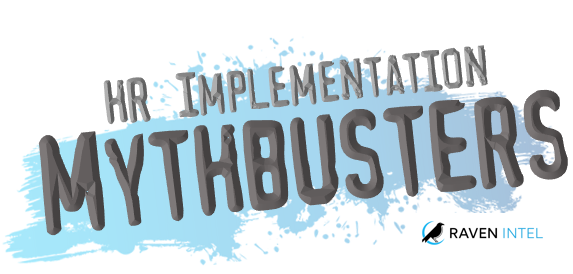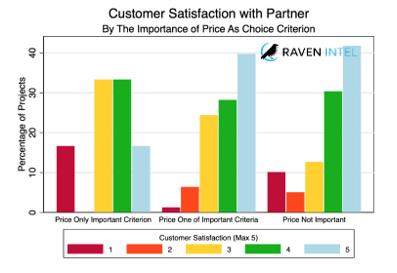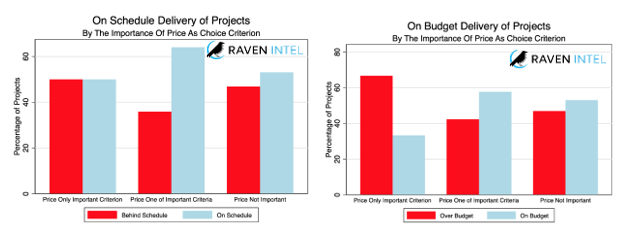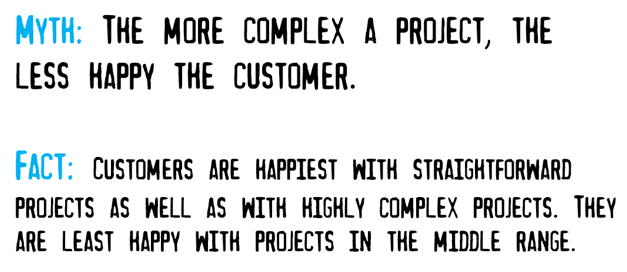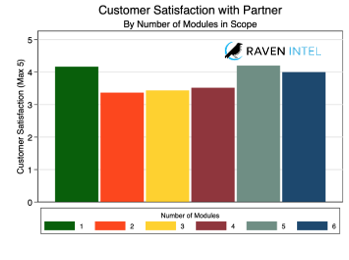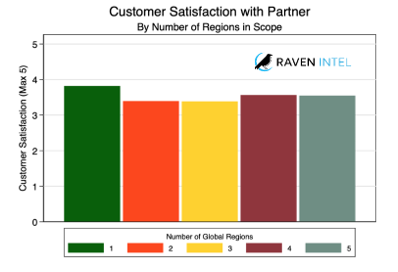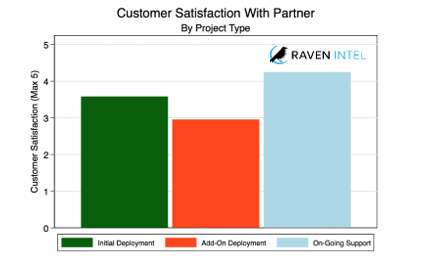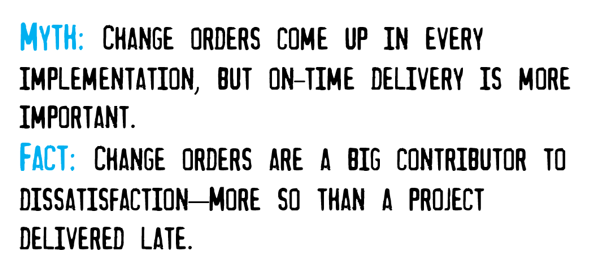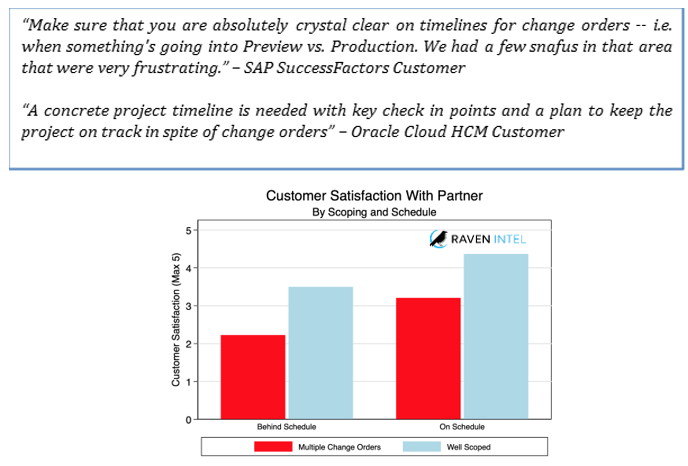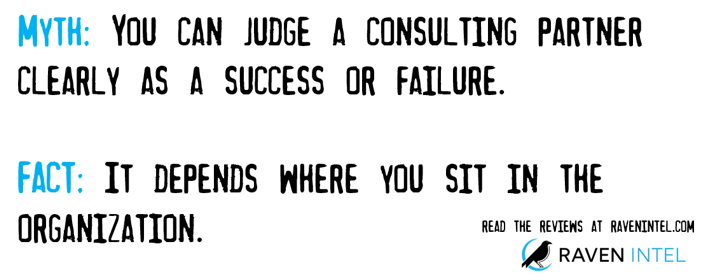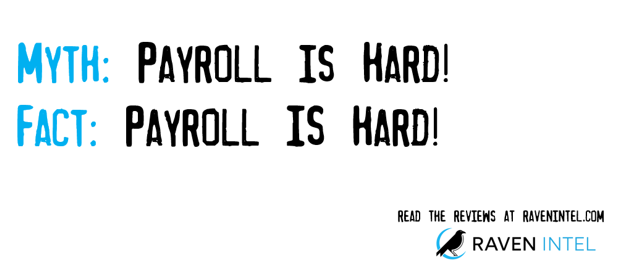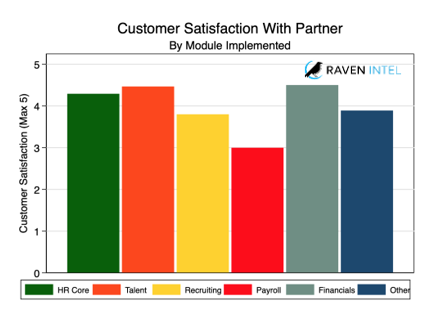Using 200+ HCM Implementation reviews of SAP SuccessFactors, Oracle HCM, Workday, Ultimate Software, ServiceNow and Cornerstone, Raven Intel debunks 6 common myths  about consulting partners and digital transformation efforts.
about consulting partners and digital transformation efforts.
Raven Intel has spoken with over 200 customers from every region, industry and size and have amassed HR software project reviews on over 500 HR software module installations. The data, knowledge and insight we have on the Consulting world and HCM softwareimplementation is unique in the HCM industry. These reviews provide data-driven insights into what is happening in the complex world of HR Tech consulting. We’ve analyzed the data and come to some surprising conclusions that flip conventional wisdom on its head.
Myth 1: The Bigger the SI, the Better.
Measured by the number of employees at the partner consulting firm, customer satisfaction is all over the map. There’s no clear pattern that larger firms produce better project outcomes for their clients.
Customer Satisfaction with the partner firm is highest for partners with 5,000-10,000 employees and second highest with firms with just 200-500 employees. If anything, customer satisfaction is more consistently high with smaller firms than large ones. 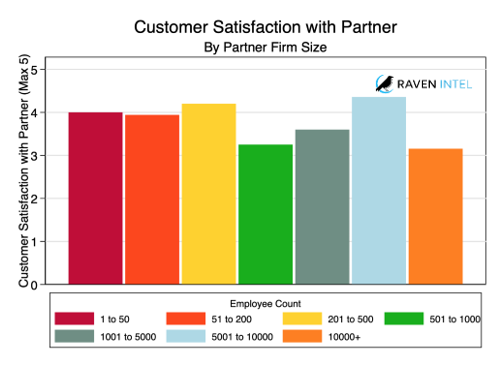
👉 Takeaway: There are other more important criteria to consider when choosing an SI. Going with a well-known / large partner provides no guarantee of success.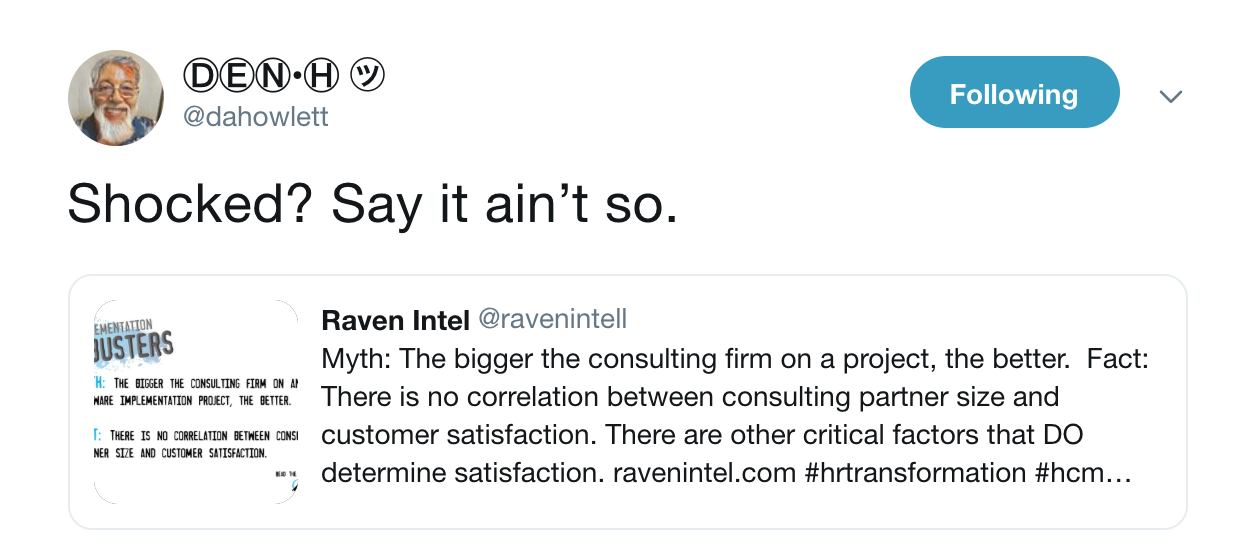
Myth 2: Price is Everything!
Projects where price is the only important criterion are worse on basically every measure: 1) Customer Satisfaction 2) On Budget delivery 3) On Schedule delivery and 4) Project Scoping.
Raven Intel asks HCM project participants what factors were important in choosing their HR implementation partner. The most common answers were:
> Experience – 66%
> Reputation – 53%
> Price – 51%
Then it drops off pretty steeply:
> Previous experience with consultant – 26%
> Vendor recommendation – 25%
> Location – 13%
Some reviewers said price was the only important factor in their choice of consulting partner. Others said that price was one of the important factors, but not the only one. Others said that price was not one of the important factors.
So how did their projects turn out?
When rating how satisfied customers were with their partner consulting firm, those who only picked price as important, gave their partners an average of 3.1 out of 5. When price was one of the important criteria, the average was 3.8 and when price was not one of the important factors, the average was 3.6.
Similarly, those who said price was the only important factor didn’t get their projects delivered on-time or on-budget as often.
👉 Takeaway: If you are choosing a partner based upon price alone, chances are you will end up paying more in the end (project scoping has a higher probability of being under-scoped, thus change orders = $$$.) Customers with a more wholistic view of quality end up with better projects.
Myth 3: The more complex a project, the less satisfied the customer will be.
Raven Intel data shows that customer satisfaction with their consulting partner follows a
U-shaped pattern with high rates of satisfaction on projects of low complexity and of high complexity.
The happiest customers are those implementing either 1 module, or implementing a full suite of modules. Partners implementing projects with one module get an average rating of 4.1. Partners with 5 and 6 module projects get ratings of 4.2 and 4.0.
The same pattern exists with regions of the world. We see that customers are happiest with their consulting partner when the project either covers only one geographic region, or if it covers four or five. Customers with projects that cover either two or three regions are less happy.
Again, we see the same pattern with the type of project. Complex initial deployments receive positive reviews. On-going projects, which are generally simpler, get a high average rating of 4.2. But in the middle, satisfaction with partners doing an add-on project is as low as 2.9.
👉 Takeaway: Don’t assume because your project is not ‘complex’ (multi-country, multimodule) or is an ‘add-on module deployment’ that you shouldn’t fully explore your partner options. We find customers who embark on complex projects do more due-diligence in partner selection, but in the middle range assume that they can just ‘go with the partner their software vendor chooses’ and everything will turn out great. Not so. When the software vendor chooses the implementation partner (not the customer), satisfaction suffers.
Myth 4: Changes Orders are no big deal.
Customers are happier with well-scoped projects that are delivered late, than on-time projects with many change orders.
Of course, the happiest customers are those with projects delivered on-time and without change orders. They’re more forgiving, though, of a late delivery than a chaotic, on-time delivery.
👉 Takeaway: Read the Statement of Work and have your whole team read it. Ask a lot of questions. This sounds like a pretty basic concept, but in some cases we’ve heard that the software salesperson has “sold” the consulting engagement along with software agreement as a rapid deployment and set the wrong expectations about project scope and delivery. This never ends well.
Myth 5: You can judge a project as a success or failure pretty clearly.
Reviewers who describe themselves as the decision makers rate their satisfaction with the consulting partner the highest, giving them an average of 4.1 out of 5. On the other end of the spectrum are those who say their role was “Other,” such as Subject Matter Expert, End User, and Analyst. They rated the partner at only 2.5.
Decision makers may rate the partner more highly because the project team is looking to present their progress in the best possible light. The decision maker who isn’t involved in the project on a daily basis may not appreciate the difficulty that the project team members faced to get the project up and running.
The perspectives of all these reviewers are important to get a full 360-degree view of the implementation partner.
👉 Takeaway: When choosing your Consulting firm, be sure to take into account multiple points of view within the organization—not just the Executive Sponsor.
Myth 6: Payroll is hard!
Raven Intel asks reviewers what modules they implemented during their project.
73% of projects involved more than one module. Here’s how it breaks down:
> HR Core – 67%
> Talent – 61%
> Recruiting – 49%
> Payroll – 39%
> Financials – 10%
> Other – 24%
When payroll is a part of the implementation effort, customers rate their partners at 3 out of 5. Payroll implementations can be the most difficult and time-consuming aspect of a rollout, with localizations and tremendous variability by geography–and there’s zero room for error. Partners implementing HR Core, Talent and Financials all get high ratings. Recruiting presents more challenges. The “Other” category includes examples of benefits, time & attendance and compensation.
👉 Takeaway: Make sure that your SI has experience in every country that you will be implementing payroll (not just “yes, we have experience in EMEA.”)


